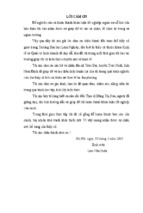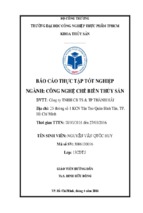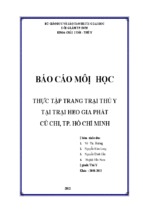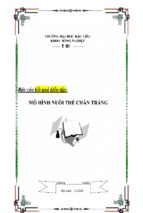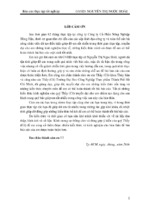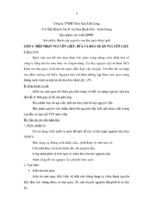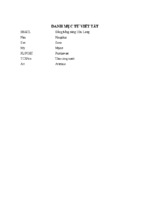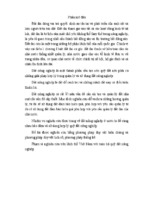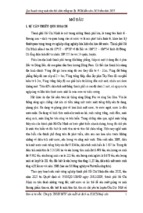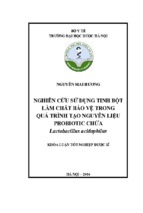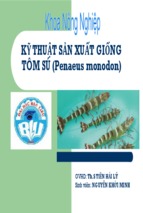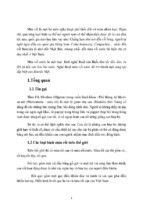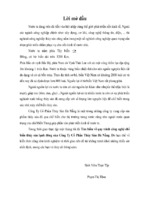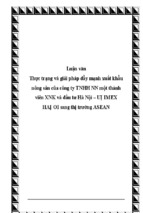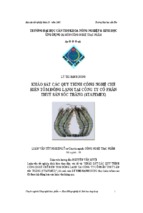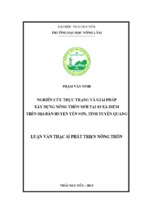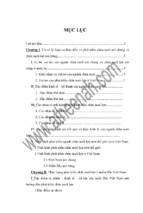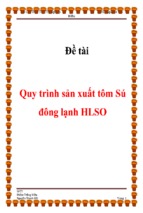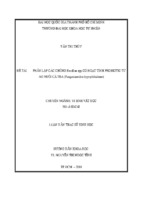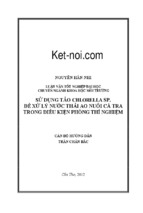nghiến biết được thành phần sinh hóa ốc bươu vàng ngoài tự nhiên
EFFECTS OF THE INVASIVE EXOTIC APPLE SNAIL (Pomacea insularum) ON THE
SNAIL KITE (Rostrhamus sociabilis plumbeus) IN FLORIDA, USA
By
CHRISTOPHER CATTAU
A THESIS PRESENTED TO THE GRADUATE SCHOOL
OF THE UNIVERSITY OF FLORIDA IN PARTIAL FULFILLMENT
OF THE REQUIREMENTS FOR THE DEGREE OF
MASTER OF SCIENCE
UNIVERSITY OF FLORIDA
2008
1
© 2008 Christopher Cattau
2
To Florida
3
ACKNOWLEDGMENTS
I would like to thank my committee members (Wiley Kitchens, Phil Darby, and Ken
Meyer) for their mentorship, advice, and encouragement. Although not officially on my
committee, Julien Martin deserves the same gratitude, as his guidance and instruction, like that
of my committee, was indispensable to the development and completion of this work. I would
also like to thank all of the graduate students and field technicians who assisted with the
collection and processing of data, including Andrea Bowling, Brian Reichert, Sara Stocco,
Christina Rich, Danny Huser, Will deGravelles, Jean Olbert, Derek Piotrowicz, Nate Richardson,
Wesley Craine, Michaela Speirs, Melinda Conners, Bridget Deemer, Courtney Hooker, Andrea
Ayala, Melissa Desa, Carolyn Enloe, and all of my fellow coworkers at the Florida Fish and
Wildlife Cooperative Research Unit. I would like to express particular gratitude to Brian
Reichert for helping me with survival analyses. This project would not have been possible
without the unwavering dedication that each of the aforementioned individuals expressed for
conservation of the snail kite and the challenging (and often arduous) work each performed to
advance our knowledge of this endangered species. This cooperative effort has allowed us to
elucidate threats to the snail kite population and to increase our understanding of their ecology,
which will lead to more reliable conservation strategies. I am enormously grateful to everyone
involved with this work.
4
TABLE OF CONTENTS
page
ACKNOWLEDGMENTS ...............................................................................................................4
LIST OF TABLES...........................................................................................................................8
LIST OF FIGURES .........................................................................................................................9
LIST OF ABBREVIATIONS........................................................................................................13
ABSTRACT...................................................................................................................................14
CHAPTER
1
INTRODUCTION ..................................................................................................................16
Study Population.....................................................................................................................17
Invasion of the Exotic Snail....................................................................................................19
Population Demography .........................................................................................................21
Study Objectives and Outline .................................................................................................23
2
EFFECTS OF THE EXOTIC APPLE SNAIL ON SNAIL KITE FORAGING
BEHAVIOR............................................................................................................................27
Background.............................................................................................................................28
Foraging Behavior ...........................................................................................................28
A Note on Pomacea Measurements ................................................................................30
The Native Apple Snail ...................................................................................................30
The Exotic Apple Snail ...................................................................................................31
Previous Foraging Studies...............................................................................................32
Prey availability........................................................................................................32
Prey negotiability and drop rate ...............................................................................34
Searching and handling time ....................................................................................35
Age and sex effects on foraging behavior ................................................................36
Energy budgets and profitability ..............................................................................37
Economic models of foraging behavior ..........................................................................38
Predictions .......................................................................................................................39
Methods ..................................................................................................................................40
Time Activity Budgets ....................................................................................................40
Sampling locations ...................................................................................................41
Selection of focal individuals ...................................................................................41
Timing and duration of observations .......................................................................42
Classification of individual kites..............................................................................43
Collection of behavioral data ...................................................................................45
Assumptions of behavioral observations..................................................................46
5
Apple Snails.....................................................................................................................47
Collection and measurement of empty snail shells ..................................................47
Collection and processing of live snails ...................................................................48
Statistical Analysis and Confidence Intervals .................................................................49
Analysis of Foraging Behavior........................................................................................49
Searching and handling time ....................................................................................51
Drop rate...................................................................................................................52
Capture rate (i.e., consumption rate) ........................................................................52
Analysis of Energetics.....................................................................................................53
Regression models and estimation of average snail weight and caloric content......53
Profitability...............................................................................................................54
Daily activity times and energy budgets ..................................................................54
Results.....................................................................................................................................56
Diet ..................................................................................................................................56
Nutritional content of apple snails ...........................................................................57
Live exotic snail measurements ...............................................................................57
Empty snail shell dimensions ...................................................................................58
Estimates of total snail weight .................................................................................58
Foraging Behavior ...........................................................................................................59
Comparing adults, subadults, and juveniles .............................................................59
Effects of the exotic snail on average searching times.............................................60
Effects of the exotic snail on average handling times ..............................................60
Effects of the exotic snail on drop rates ...................................................................61
Effects of the exotic snail on capture rates...............................................................62
Effects of the Exotic Snail on Energetics ........................................................................63
Estimates of caloric content .....................................................................................63
Profitability...............................................................................................................64
Validation of time activity budget extrapolations ....................................................64
Daily activity patterns ..............................................................................................65
Daily energy balances ..............................................................................................65
Discussion...............................................................................................................................66
3
DEMOGRAPHIC EFFECTS OF THE EXOTIC APPLE SNAIL ON THE KITE .............104
Introduction...........................................................................................................................104
Reproduction .................................................................................................................105
Survival..........................................................................................................................105
Predictions .....................................................................................................................106
Methods ................................................................................................................................107
Nesting Effort and Reproductive Success .....................................................................108
Survival..........................................................................................................................111
Results...................................................................................................................................113
Reproduction .................................................................................................................113
Nesting effort..........................................................................................................113
Nest success and productivity ................................................................................114
6
Survival..........................................................................................................................114
Apparent annual survival .......................................................................................114
Apparent monthly survival.....................................................................................115
Discussion.............................................................................................................................116
4
IS LAKE TOHOPEKALIGA FUNCTIONING AS AN ECOLOGICAL TRAP FOR
THE SNAIL KITE IN FLORIDA? ......................................................................................137
Introduction...........................................................................................................................137
Ecological Trap Theory.................................................................................................137
A Hypothetical Example ...............................................................................................137
Recent Nesting History..................................................................................................138
Lake Tohopekaliga ........................................................................................................139
Methods ................................................................................................................................139
Hypothesis 1 ..................................................................................................................139
Hypothesis 2 ..................................................................................................................140
Hypothesis 3 ..................................................................................................................140
Results...................................................................................................................................141
Hypothesis 1 ..................................................................................................................141
Hypothesis 2 ..................................................................................................................142
Hypothesis 3 ..................................................................................................................142
Discussion.............................................................................................................................143
APPENDIX DERIVATION OF DAILY ENERGY EXPENDITURE.......................................152
LIST OF REFERENCES.............................................................................................................153
BIOGRAPHICAL SKETCH .......................................................................................................164
7
LIST OF TABLES
Table
page
2-1
Number of TABs conducted by month and location in 2003, 2004, 2005, 2006 (postinvasion) and in 1993, 1994, 1996 (pre-invasion). ............................................................71
2-2
Nutritional contents of P. insularum..................................................................................71
2-3
Nutritional composition of P. insularum versus P. paludosa............................................72
2-4
Average daily activity pattern of the snail kite in Florida. ................................................72
3-1
The number of nests initiated range-wide and the contribution from Toho, 1995-2007.121
3-2
Model selection table for apparent annual survival of kites hatched on Toho. ...............121
3-3
Model selection table for apparent monthly survival of kites hatched on Toho..............121
8
LIST OF FIGURES
Figure
page
1-1
Major habitat fragments within the range of the snail kite in Florida ...............................24
1-2
Confirmed locations, as of 2007, of the exotic snail (P. insularum) within the range
of the snail kite in Florida. Larger circles encompass multiple small populations in
close proximity...................................................................................................................25
1-3
Movements of approximately 50 radio-tagged adult snail kites among wetland
fragments over a one-year period. April 1992-April 1993 ................................................26
2-1
Relative sizes of exotic apple snails...................................................................................73
2-2
Measurement of snail shells...............................................................................................74
2-3
Location of apple snail traps on Toho................................................................................74
2-4
Linear regression models of exotic snail weight and morphology. ...................................75
2-5
Number of native and exotic apple snails captured per year with funnel traps on
Toho, 2005-2007................................................................................................................76
2-6
Proportion of native to exotic apple snails captured in five locations on Toho, 20052007....................................................................................................................................77
2-7
Average length of apple snail shells collected from feeding perches and nests in nine
wetlands throughout the range of the snail kite, 2004-2007..............................................78
2-8
Average shell dimensions of native and exotic apple snails consumed by kites, 20042007....................................................................................................................................79
2-9
Estimated whole weight of native and exotic snails negotiated by foraging kites
during the post-invasion era...............................................................................................80
2-10
Average handling times for adult, juvenile, and subadult kites on Toho and KissWCA3A during the post-invasion era................................................................................81
2-11
Average drop rates for adult, juvenile, and subadult kites on Toho and Kiss-WCA3A
during the post-invasion era...............................................................................................82
2-12
Average capture rates for adult, juvenile, and subadult kites on Toho and KissWCA3A during the post-invasion era................................................................................83
2-13
Average searching times for adult, subadult, and juvenile kites on Toho and KissWCA3A during the post-invasion era................................................................................84
9
2-14
Average searching times for adult male and female kites on Toho and Kiss-WCA3A
during the post-invasion era...............................................................................................85
2-15
Average searching times for adult kites on Kiss and WCA3A during the postinvasion era and on Toho during the pre- and post-invasion eras. ....................................86
2-16
Average searching times for juvenile kites on Toho and Kiss-WCA3A during the
post-invasion era. ...............................................................................................................87
2-17
Average handling times for adult male and female kites on Toho and Kiss-WCA3A
during the post-invasion era...............................................................................................88
2-18
Average handling times for adult kites on Kiss-WCA3A during the post-invasion era
and on Toho during the pre- and post-invasion eras..........................................................89
2-19
Average handling times for juvenile kites on Toho and Kiss-WCA3A during the
post-invasion era.. ..............................................................................................................90
2-20
Raw group drop rates for adult and juvenile kites on Toho and Kiss-WCA3A during
the post-invasion era ..........................................................................................................91
2-21
Average drop rates for adult male and female kites on Toho and Kiss-WCA3A
during the post-invasion era...............................................................................................92
2-22
Average drop rates for adult and juvenile kites on Toho and Kiss-WCA3A during the
post-invasion era. ...............................................................................................................93
2-23
Average capture rates for adult male and female kites on Toho and Kiss-WCA3A
during the post-invasion era...............................................................................................94
2-24
Average capture rates for adult kites on Kiss and WCA3A during the post-invasion
era and on Toho during the pre- and post-invasion eras....................................................95
2-25
Average capture rates for juvenile kites on Toho and Kiss-WCA3A during the postinvasion era. .......................................................................................................................96
2-26
Estimated energetic content of native and exotic snails consumed by kites during the
post-invasion era.. ..............................................................................................................97
2-27
Average proportion of time spent flying during day-long and hourly observations by
kites on Toho, Kiss, and WCA3A in the post-invasion era. ..............................................98
2-28
Average capture rates achieved by foraging kites during morning, afternoon, and
evening observations on Toho and Kiss-WCA3A in the post-invasion era. .....................99
2-29
Average proportion of time spent flying by all kites on Kiss, Toho, and WCA3A
during the post-invasion era.............................................................................................100
10
2-30
Average proportion of time spent flying by adult and juvenile kites on Toho and
Kiss-WCA3A during the post-invasion era.. ...................................................................101
2-31
Estimated gross daily energetic gains for adult and juvenile kites foraging on Toho,
Kiss, and WCA3A during the post-invasion era..............................................................102
2-32
Estimated daily energy balances for adult and juvenile kites on Toho, Kiss, and
WCA3A during the post-invasion era..............................................................................103
3-1
Annual number of snail kite nests initiated range-wide, 1995-2007. ..............................122
3-2
Average number of nests initiated annually on Toho during the pre- and postinvasion eras. Post-invasion estimate excludes 2004.. ....................................................123
3-3
Number of nests initiated annually on Toho, 1995-2007. ...............................................124
3-4
Relative annual contribution of Toho to the total nesting effort range-wide, 19952007..................................................................................................................................125
3-5
Trend model expressing the increasing contribution of Toho to the total population
nesting effort over time (includes all years 1995-2007). .................................................126
3-6
Trend model expressing the increasing contribution of Toho to the total population
nesting effort over time (excludes drought years 2001, 2007 and drawdown year
2004) ................................................................................................................................127
3-7
Relative contribution of Toho to the total population nesting effort during the preand post-invasion eras......................................................................................................128
3-8
Annual nest success on Toho, 1995-2007........................................................................129
3-9
Average nest success on Toho during the pre- and post-invasion eras............................130
3-10
Annual number of young fledged per successful nest on Toho, 1995-2007. ..................131
3-11
Average nest productivity on Toho during the pre- and post-invasion eras. ...................132
3-12
Average number of young fledged per successful nest on Toho vs. all other wetlands
during the post-invasion era.............................................................................................133
3-13
Apparent annual survival of juveniles hatched on Toho during the pre- and postinvasion eras.....................................................................................................................134
3-14
Apparent annual survival of juveniles hatched on Toho, 1992-2006. .............................135
3-15
Apparent monthly survival of juveniles hatched on Toho during the pre- and postinvasion eras.....................................................................................................................136
11
4-1
Average number of nests initiated annually on nine wetlands during the postinvasion era. .....................................................................................................................147
4-2
Annual nest success on nine wetlands during the post-invasion era. ..............................148
4-3
Annual nest productivity on nine wetlands during the post-invasion era........................149
4-4
Total number of nests initiated annually on nine wetlands during the post-invasion
era.....................................................................................................................................150
4-5
Total number of young fledged per year (uncorrected counts) on nine wetlands
during the post-invasion era.............................................................................................151
12
LIST OF ABBREVIATIONS
95% CI
Ninety-five percent confidence interval
AOU
American Ornithologists’ Union
df
Degrees of freedom
FFWCC
Florida Fish and Wildlife Conservation Commission
KISS (or Kiss)
Lake Kissimmee
n
Sample size
SD
Standard Deviation
SFWMD
South Florida Water Management District
TAB
Time Activity Budget
TOHO (or Toho)
Lake Tohopekaliga
USACE
United States Army Corp of Engineers
USFWS
United States Fish and Wildlife Service
WCA3A
Water Conservation Area 3A
x
Sample mean
13
Abstract of Thesis Presented to the Graduate School
of the University of Florida in Partial Fulfillment of the
Requirements for the Degree of Master of Science
EFFECTS OF THE INVASIVE EXOTIC APPLE SNAIL (Pomacea insularum) ON THE
SNAIL KITE (Rostrhamus sociabilis plumbeus) IN FLORIDA, USA
By
Christopher Cattau
May 2008
Chair: Wiley Kitchens
Major: Wildlife Ecology and Conservation
The Snail Kite (Rostrhamus sociabilis plumbeus) is an endangered raptor in the U.S. that
exhibits an extreme form of dietary specialization, feeding almost exclusively on one species of
freshwater snail, the Florida Apple Snail (Pomacea paludosa Say). Lake Tohopekaliga, one of
the few remaining wetland fragments utilized by the snail kite in Florida, recently experienced an
infestation of the invasive exotic Island Apple Snail (Pomacea insularum), which is relatively
larger (length, x = 63.5 mm; weight, x = 56.8 g) than the native apple snail (length, x = 37.6 mm;
weight, x = 15.9 g). This relative size difference raised questions about the ability of kites
(especially juveniles) to negotiate exotic snails, and given the sensitivity of the kite population to
recruitment, we conducted a comparative observational study to elucidate the effects of the
exotic apple snail on snail kite foraging behavior, energetics, nest success, and survival.
Relative to native snails, we found that exotic snails require longer handling times (for
adults, 302 vs. 72 seconds; for juveniles, 496 vs. 97 seconds), lead to increased drop rates (for
adults, 0.21 vs. 0.02; for juveniles, 0.33 vs. 0.06), and result in depressed capture rates (for
adults, 1.09 vs. 3.30 snails/hour; for juveniles, 0.78 vs. 3.46 snails/hour); however, we also found
that exotic snails provide more energy than natives (12.92 vs. 4.84 kcal/snail). Consequently, the
effects of the exotic snail on foraging behavior do not have negative energetic repercussions for
14
adult kites. In fact, we found that adult kites are attracted to Lake Tohopekaliga and that the
relative contribution of the lake to the range-wide nesting effort increased from 6% to 33% after
the invasion of the exotic snail. Conversely, the effects of the exotic snail on juvenile foraging
behavior can lead to insufficient daily energy balances and may suppress juvenile survival.
Given the critically endangered status of the snail kite and the propensity of the exotic apple snail
to spread, this work suggests that serious management and conservation initiatives that address
the exotic apple snail may be necessary to prevent further deleterious consequences for the kite
population in Florida
15
CHAPTER 1
INTRODUCTION
Species dependent upon specialized niches are particularly subject to environmental
perturbations (Brown & Maurer 1989; Owens & Bennett 2000; Purvis et al. 2000): narrow
dietary breadth is one such specialization (Real & Caraco 1986; Begon et al. 1996). In fact,
niche specialization is positively correlated with extinction risk across a wide range of taxa
(Owens & Bennett 2000; Purvis et al. 2000), including birds (Hughes et al. 2000). The snail kite
(Rostrhamus sociabilis plumbeus) is a wetland-dependent raptor that displays an extreme form of
dietary specialization, feeding almost exclusively on a single species of apple snail (Pomacea
paludosa Say) (Howell 1932; Stieglitz & Thompson 1967), the only species of this genus native
to Florida (Rawlings et al. 2007). After several decades of landscape fragmentation and
hydroscape alteration, the kite population is now confined to a patchwork of freshwater wetlands
that remain within its historical range, and the viability of the population rests entirely on the
conditions and dynamics of these wetland fragments (Sykes 1979, 1987a; Bennetts & Kitchens
1992, 1997; Martin 2007). However, many of the remaining wetlands are no longer sustained by
the natural processes under which they evolved (USFWS 1999; RECOVER 2005), and hence,
are not necessarily characteristic of the historical ecosystems that once supported the kite
population (Bennetts & Kitchens 1992, 1997, 1999; Martin 2007). Snail kites now face another
potential threat, the recently established populations of the invasive exotic apple snail (Pomacea
insularum) in Florida.
Evidence suggests that the exotic apple snail negatively affects the food handling ability of
snail kites (Darby et al. 2007), and there is speculation as to what the consequences for the kite
population may be (Darby et al. 2007; Rawlings et al. 2007), but many unanswered questions
remain. The snail kite already faces a high risk of extinction (Martin 2007), so the complications
16
experienced by kites attempting to exploit exotic apple snails are of particular concern, especially
given that populations of the native apple snail have been declining throughout the kites’ range
(Darby et al. 2005) while populations of the exotic snail in Florida have been spreading
(Rawlings et al. 2007). Native snail populations have declined largely in the absence of exotic
snails; hence, these population trends are likely coincidental, but they are concerning
nonetheless. Both snail species have characteristics that may influence their utility to snail kites.
The elucidation of these differences, and of their respective effects on snail kite foraging
behavior, energetics, and population demography, is an essential prerequisite to future
conservation planning.
Study Population
Snail kite (Rostrhamus sociabilis) populations occur in North, Central, and South America.
Based on apparent geographical variations in body size, distinctions are drawn among three
subspecies (i.e., R. s. major, R .s. sociabilis, and R. s. plumbeus), which are recognized by the
American Ornithologists’ Union (AOU) (Amadon 1975). However, only a small number of
morphometric measurements were used to separate these subspecies, and the tenuous
methodology has been called into question by numerous authors (e.g., Beissinger 1988, Bennetts
& Kitchens 1997, Martin 2007). While the AOU states that R. s. plumbeus occurs in both the
United States and Cuba (Amadon 1975), there is no documentation of movement between these
two geographic locations (Bennetts & Kitchens 1997; Martin 2007). Furthermore, the
aforementioned classification scheme of subspecies, which pools the Florida and Cuba
populations together, has no genetic basis (Beissinger 1988; Martin 2007). Although no study
has directly addressed the relationship between the Florida and Cuba snail kite populations,
multiple studies (e.g., Sykes 1979; Beissinger et al. 1983; Bennetts & Kitchens 1997; Dreitz et
al. 2002; Martin et al. 2006a) of movement and population dynamics suggest that the snail kite
17
population in Florida is isolated. This study addresses the Florida snail kite population only, and
for all practical conservation purposes, we also consider this population geographically isolated.
The snail kite (Rostrhamus sociabilis plumbeus) is an endangered raptor (Federal Register
1967, 2007) whose range in the U.S. is confined to the freshwater wetlands of central and
southern Florida (Sykes 1984; Bennetts & Kitchens 1992, 1997; Martin 2007). As an extreme
dietary specialist, dependent almost entirely on a single species of freshwater apple snail
(Pomacea paludosa, from here on referred to as the native snail or native apple snail) for food,
the snail kite is a wetland-dependent species (Howell 1932; Stieglitz & Thompson 1967; Snyder
& Snyder 1969; Sykes 1987a). In addition to foraging, nesting is also tied directly to wetland
habitats. Snail kites always build nests in vegetation surrounded by standing water, which aids
in the deterrence of terrestrial predators (Stieglitz & Thompson 1967; Sykes 1987b; Beissinger
1988). Over the past several decades, landscape fragmentation and hydroscape alteration have
severely jeopardized the quantity and quality of the historically contiguous wetland habitats that
once comprised the range of the snail kite in Florida (Bennetts & Kitchens 1997, 2000; Kitchens
et al. 2002; Martin 2007). The major remaining wetland fragments used by the snail kite are
depicted in Figure 1-1 and include the following: Everglades National Park (ENP), Big Cypress
National Preserve (BICY), Water Conservation Areas (WCA) 1A, 2A, 2B, 3A, 3B, Lake
Okeechobee (OKEE), Grassy Waters Preserve (GW), Saint John’s Marsh (SJM), Lake
Kissimmee (KISS), Lake Tohopekaliga (TOHO), and East Lake Tohopekaliga (ETOHO)
(Bennetts & Kitchens 1997; Dreitz 2000; Kitchens et al. 2002; and Martin et al. 2006a). As of
2007, only one of the major wetlands utilized by the snail kite, Lake Tohopekaliga (from here on
referred to simply as Toho), has suffered a major invasion of P. insularum (from here on referred
to as the exotic snail or exotic apple snail) (Rawlings et al. 2007; Darby et al. 2007); however,
18
confirmed exotic snail populations exist in close proximity to many of the other primary
wetlands used by the kite in Florida (Rawlings et al. 2007) (Figure 1-2).
Within Florida, the kite population is described as nomadic, and monthly movement
probabilities among wetland fragments may be as high as 0.25 (Bennetts & Kitchens 1997,
2000). More recent analyses, which include multiple levels of spatial and temporal resolution,
suggest that the monthly movement probability among contiguous fragments differs significantly
from that among isolated fragments (0.29 vs. 0.10, respectively) (Martin et al. 2006a, 2007b).
However, numerous studies, of both movement (Sykes 1979; Rodgers et al. 1988; Bennetts &
Kitchens 1992, 1997; Martin 2007) and genetics (Rodgers & Stangel 1996), confirm that the
spatial distribution of kites in Florida shifts temporally and that sufficient individual movement
among wetlands occurs, thus uniting the entire Florida population (Figure 1-3). Even though the
exotic snail has thus far only infested one of the major wetlands utilized by the snail kite, the kite
population in Florida does not function as a metapopulation (Bennetts & Kitchens 1997, 2000;
Martin et al. 2006b, 2007b; Martin 2007); therefore, the scope of our project covers the entire
kite population.
Invasion of the Exotic Snail
The exotic apple snail (P. insularum), commonly known as the island apple snail, is native
to Argentina, Brazil, and Bolivia. The invasion history of the exotic apple snail is somewhat
unclear (Rawlings et al. 2007). P. insularum, along with other members of the Pomacea genus
that have invaded the U.S., have historically been misidentified as P. canaliculata or lumped
together with other species in what was called the Canaliculata (or, channeled apple snail)
complex (Thompson 1997; Howells et al. 2006; Rawlings et al. 2007). Reliable genetic analysis
confirming the presence of P. insularum in Florida dates back to only 2002 (Rawlings et al.
2007); however, exotic snails observed on Toho in 2001 were later identified as P. insularum
19
(Darby, personal communication). Many new populations of P. insularum were observed in
Florida from 2004 to 2006, suggesting that it may be a relatively new invasive species to the
state (Rawlings et al. 2007).
The exotic apple snail is known to feed on the eggs of congeneric snails, and some
anecdotal evidence suggests that native apple snail populations appear to decline or even
disappear after the introduction of the exotic snail (Rawlings et al. 2007); however, native snail
populations have declined largely in the absence of exotic snails, and the declining native snail
populations have been attributed to other sources, such as altered hydrologic regimes and shifts
in vegetative communities (Kushlan 1975; Turner 1996; Darby et al. 2003).
The ecology of Toho has undergone drastic anthropogenic changes recently. As part of a
management strategy aimed at improving habitat conditions for fish populations, a drawdown of
the lake stage occurred between late-2003 and early-2004, and an intensive scraping treatment of
littoral vegetation followed. After this treatment, water levels on Toho remained low until June
2004. This course of action significantly altered the physical and biological conditions of the
lake’s littoral zone (Welch 2004; Williams et al. 2005). The emergent vegetation in the littoral
zone is a critical component of suitable snail kite foraging habitat (Sykes 1987a; Bennetts &
Kitchens 1997), and once it was removed via mechanical scraping, kites temporarily abandoned
Toho (Martin et al. 2003; Kitchens et al. 2005), subsequently returning in late-2004 (Kitchens et
al. 2005; Martin et al. 2006b). In the interim, the distribution and abundance of exotic apple
snails on Toho grew dramatically (Kitchens et al. 2005). Prior to the drawdown and scraping
treatment, native snails dominated the littoral habitats on Toho, while the exotic snails were
largely confined to the pelagic habitats on the interior side of the lake. However, the drawdown
and scraping treatment, as well as the prolonged dry conditions that followed it, greatly
20
- Xem thêm -

